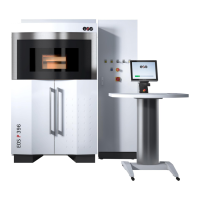
Do you have a question about the EOS P 396 and is the answer not in the manual?
| Technology | Laser sintering |
|---|---|
| Build Volume | 340 x 340 x 600 mm |
| Laser Type | CO2 |
| Materials | Polyamide (PA) |
| Power Requirements | 400 V, 32 A |
Document reproduction, distribution, and modification restrictions.
Overview of the training manual's structure and scope.
Explanation of formatting conventions used in the manual.
Key terminology and their formal definitions used in the document.
Explanation of symbols for notices/warnings and general safety advice.
Contact details and required information for EOS technical support.
Introduces the fundamental principles of the laser sintering process.
Details the step-by-step procedure of the laser sintering build.
Explains key parameters influencing the laser sintering outcome.
Visual identification of main machine components and their arrangement.
Explanation of the operational principles and processes of the machine.
Details the function and types of the machine's cooling system.
Overview of IPCM EOSINT P 3 and related powder conveying systems.
Information on available EOS plastic powders and their properties.
Covers powder damage, separation, sieving, refreshing, and mixing.
Recommended storage conditions for plastic powder to maintain quality.
Information on EOS-approved materials for the machine.
Overview of standardizing part properties and manufacturing processes.
Explanation of OEP, PPP, and Customer parameter sets for machine usage.
Details on exposure types and specific PPP parameter sets like TopSpeed and Speed.
Tools for customizing exposure and parameter settings using Exposure Editor.
Steps from CAD construction to job preparation for the machine.
Detailed guide on using Magics RP for part preparation tasks.
Using the Fix Wizard for automatic error correction and orienting parts.
Utilizing RP-Tools for slicing, analyzing, and correcting part data.
Procedures for installing and licensing EOS software products.
Steps for setting up the machine and preparing jobs using PSW.
Adjusting parameters like shrinkage, offset, and managing build processes.
Using EOSTATE for monitoring and procedures for machine shutdown and powder handling.
Procedures for verifying and adjusting the machine's building temperature.
Methods for measuring and adjusting material-dependent shrinkage and beam offset.
Strategies for backing up configurations and documenting build processes.
Procedures for exporting job data, recording temperatures, and archiving results.
Common mechanical malfunctions and process problems encountered with the machine.
Addressing powder scoring, cracks, recoater levels, and part defects.
Crucial maintenance procedure for cleaning the laser window to ensure optimal performance.